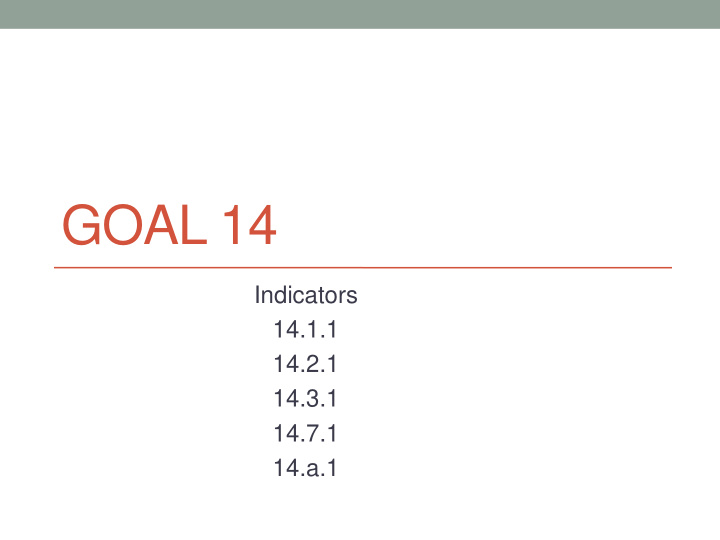



GOAL 14 Indicators 14.1.1 14.2.1 14.3.1 14.7.1 14.a.1
Indicator 14.1.1 – Definitions Part 1 Current proposal: Index of Coastal Eutrophication (ICEP) Inputs of nutrients (nitrogen, phosphorus and silica, in different forms) from rivers, and corresponding nutrient-ratio sub-indicator – consensus that it will not be operational for several years Replacement Proposal: Chlorophyll-a concentration as an indicator of phytoplankton biomass • Regional Seas Conventions and Action Plans: Core Indicator • Widely monitored: HELCOM, OSPARCOM, MAP and NOWPAP
Indicator 14.1.1 – Definitions Part 2 Current Proposal: Floating Plastic Debris Density • Regional Seas Conventions and Action Plans: part of Core Indicator on Marine Litter • Regional standardization of UNEP-IOC Guideline still required • Alternative Proposal: Quantification and classification of Beach Litter Items • Regional Seas Conventions and Action Plans: Core Indicator; • Regional standardization underway • Widely monitored: HELCOM, OSPARCOM, MAP and NOWPAP • Does not require extensive financial investment
Methodology – Timeframe - Agencies Chlorophyll-a • Collected by national monitoring mechanisms for Regional Seas Conventions Programmes (RSCP) • In-situ sampling and remote sensing methodologies in place • 2016 – Expert meetings with countries • Co-ordinated report every 3-4 years. • UNEP - IOC-UNESCO - Regional Seas Convention and Action Plans Marine litter – beach litter items • UNEP/IOC guideline - testing period has begun with UNEP, Regional Seas in close collaboration with IOC-UNESCO • Co-ordinated global report every 3-4 years • UNEP - IOC-UNESCO - Regional Seas Convention and Action Plans
Indicator 14.2.1- Definition 14.2.1 Proportion of national Exclusive Economic Zones managed using ecosystem-based approaches • National Integrated Coastal Zone Management guidelines and enabling legislation adopted as Regional Seas Conventions, • Standardized terminologies and definitions may be needed for inter-regional comparisons • An incremental and spatially-explicit measure is under development to define ‘Ecosystem Approach’
Methodology – Timeframe - Agencies Methodology Integrated Coastal Zone Management • Existing national reporting methodologies in each region • UNEP-Live for reporting national progress and lessons on marine spatial planning • UNEP to support consolidated reporting for Core Regional Seas Indicator Set adopted 2015 Time Frame • September 2016: Regional Seas Indicators Working Group • Ecosystem Approach methodology: 12-18 months. Agencies • UNEP – IOC-UNESCO – FAO - Regional Seas Conventions • Coordination with Multilateral Environmental Agreement reporting, notably Convention on Biodiversity Aichi Target 11
Indicator 14.3.1- Definition 14.3.1 Average marine acidity (pH) measured at agreed suite of representative sampling stations • The Regional Seas Conventions Core indicator set includes measurement of ocean acidification through Aragonite saturation, pH, or Alkalinity and annual mean seas surface temperature (25m below surface) • Definitions agreed through Global Ocean Acidification Observing Network (GOA-ON): Requirements and Governance Plan and Essential Ocean Variables within the Global Ocean Observing System (GOOS).Suite of representative sampling stations compiled through GOA-ON and GOOS • Impact on coral reefs Global Coral Reef Monitoring Network (GCRMN) definition and survey design; every 4 years
Methodology – Timeframe - Agencies Methodology • UNEP and the Regional Seas Secretariats are compiling data across all regions Timeframe • Ocean acidification: ongoing assessment as part of GOOS and GOA-ON; ROPME and Caribbean already have reporting • Global Coral Reef Monitoring: global report in 2020 and regional GCRMN assessments and regional databases: Caribbean 2014; Western Indian Ocean 2016; Pacific Islands and Eastern Tropical Pacific 2017 • Agencies • Ocean acidification: UNEP will co-lead with IOC-UNESCO (GOOS and GOA-ON) • Coral Reef Monitoring: UNEP in collaboration with ICRI, GCRMN, Regional Seas Conventions and Action Plans
Indicator 14.a.1- Definition 14.a.1 Proportion of total research budget allocated to research in the field of marine technology • The definition of marine technology is described in the published IOC-UNESCO Guidelines on Transfer of Marine Technology
Methodology – Timeframe - Agencies Methodology • part of the preparation of the Global Ocean Science Report (GOSR) launched by IOC Member States in 2014 • Preliminary information gathered through national surveys • Analyzed to quantify research investment, research capacity and infrastructure, in particular human resources and the facilities/laboratories/field stations, as well as special equipment Timeframe • 2016: baseline information through IOC GOSR • Technical expert end of 2016/beginning of 2017 with aim of finalizing the indicator methodology and protocols for collecting data at national scale Agencies • IOC- UNESCO, UNEP, OECD, FAO and UNESCO’s Institute of Statistics
Goal 14 Conclusions • 14.1.1Proposed alternative indicators: Chlorophyll-a and Marine Beach Litter Items; both available in more than 50% countries and with standardized methodologies. Include asTier II • 14.2.1 Methodology and reporting in place through Regional Seas Conventions. Revert to Tier II • 14.3.1 Retain indicator but as Tier II under Regional Seas Conventions and Action Plans Core Indicator Set reporting. Revert Tier II • 14.a.1 Retain as Tier III with IOC-UNESCO as custodian agency
Recommend
More recommend